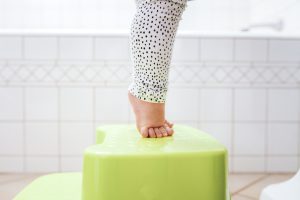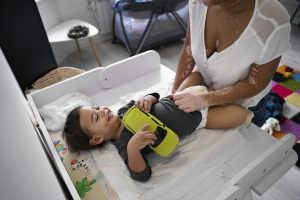
The one-size-fits-all approach to toilet training fails because boys and girls face fundamentally different challenges during the learning process. Understanding these gender-specific differences – from physical development to learning styles to social expectations – allows parents to choose strategies that work with their child’s natural tendencies rather than against them.
For boys especially, successful toilet training requires addressing unique challenges like aim training, toilet seat etiquette, and the transition between sitting and standing positions. Tools like the Willy Light become essential for teaching these male-specific skills while building consideration for others from an early age.
This guide reveals the key differences between toilet training boys and girls, providing gender-specific strategies that lead to faster, more successful outcomes for both.
When Sarah’s daughter Emma mastered toilet training at 2.5 years old, Sarah assumed the same gentle, patient approach would work equally well for her son Jake. Six months later, with bathroom floors constantly requiring cleanup and Jake showing little interest in precision or consistency, Sarah realized a crucial truth: boys and girls don’t just learn differently – they face completely different toilet training challenges.
The one-size-fits-all approach to toilet training sets families up for frustration because it ignores the fundamental physical, developmental, and social differences between boys and girls. Success comes from understanding these differences and adapting your strategy accordingly.
Why Gender-Specific Strategies Matter
Research consistently shows that boys and girls follow different developmental timelines and respond to different motivational approaches during toilet training. Ignoring these differences often leads to:
For boys: Extended training periods, persistent mess issues, and missed opportunities to establish proper etiquette early For girls: Unnecessary pressure, rushed timelines, and overlooked confidence-building opportunities For families: Increased stress, inconsistent results, and the frustration of using strategies that don’t match the child’s natural learning style
Understanding gender-specific needs transforms toilet training from a battle of wills into a collaborative learning process.
The Timeline Reality: When Boys vs Girls Typically Train
Girls: Earlier Start, Faster Progress
Most girls show toilet training readiness between 20-24 months and achieve daytime independence by age 2.5-3. Key factors contributing to earlier success:
Physical development: Girls typically develop bladder control and fine motor skills earlier Communication advantages: Earlier language development helps with expressing bathroom needs Social motivation: Often respond well to praise, pretty underwear, and social approval Sitting simplicity: Single position mastery reduces complexity
Boys: Later Start, Different Challenges
Boys commonly begin showing readiness between 2.5-3 years and may not achieve complete independence until 3.5-4 years. Contributing factors:
Physical development: Later maturation of fine motor control and spatial awareness Complexity factors: Must master both sitting and standing positions, plus aim requirements Etiquette learning: Need explicit teaching about toilet seat management and bathroom courtesy Independence focus: Often more motivated by autonomy than social approval
These timelines are general patterns – every child develops individually. However, understanding typical gender differences helps set realistic expectations and choose appropriate strategies.

Physical Differences That Impact Training
Girls: Straightforward Mechanics
Female anatomy creates relatively straightforward toilet training requirements:
- Single sitting position for all bathroom functions
- Consistent wiping technique (front to back)
- Stable, predictable positioning
- Less complex cleanup requirements
Boys: Multi-Position Mastery
Male anatomy introduces several training complexities:
- Two positions to master (sitting and standing)
- Aim requirements for standing urination
- Decision-making about which position to use when
- Toilet seat positioning considerations
- More variables affecting accuracy and cleanliness
These physical differences explain why boys often need additional visual cues and feedback systems to master bathroom skills successfully.
Learning Style Differences
How Girls Typically Learn Best
Social connection: Respond well to praise, encouragement, and making others happy Detail orientation: Often naturally careful with hygiene and positioning Communication-based: Benefit from verbal instructions and explanations Routine comfort: Adapt well to consistent schedules and predictable processes Visual organization: Respond to charts, stickers, and organized reward systems
Effective strategies for girls:
- Detailed step-by-step instructions
- Social praise and recognition
- Pretty or special underwear as motivation
- Mother-daughter bathroom time for modeling
- Hygiene emphasis from the beginning
How Boys Typically Learn Best
Action-oriented: Learn through doing and experimenting Goal-focused: Motivated by challenges, games, and achieving targets Visual-spatial: Respond to clear visual feedback and spatial challenges Independence-seeking: Prefer autonomy over social approval Immediate feedback: Need instant results to maintain engagement
Effective strategies for boys:
- Target practice and aim games
- Immediate visual feedback systems like the Willy Light
- Independence-building rather than constant supervision
- Physical challenges and skill-building focus
- Clear, simple rules with consistent enforcement
The Aim Training Challenge: Boys’ Unique Requirement
One of the most significant differences in toilet training boys is the need for aim training – a skill girls never need to develop. This creates several specific challenges:
Starting with Sitting
Most experts recommend beginning with sitting for all bathroom functions:
- Reduces variables during initial learning
- Allows focus on basic bathroom routine
- Prevents early mess and frustration
- Builds confidence before adding complexity
Transitioning to Standing
The transition to standing urination typically happens around ages 3-4:
- Requires developed spatial awareness
- Needs consistent practice and feedback
- Benefits from target games and fun approaches
- Demands patience during the learning curve
Building Accuracy Skills
Successful aim training requires: Visual targets: Toilet targets, cereal pieces, or special toilet bowl additives Immediate feedback: Systems that show results instantly – the Willy Light excels here by providing clear visual confirmation when proper bathroom etiquette is maintained Practice opportunities: Regular standing practice sessions Positive reinforcement: Celebrating improvements rather than criticizing misses
Etiquette Training: Critical for Boys
While girls naturally learn basic bathroom etiquette through their simpler bathroom routine, boys need explicit etiquette training that covers:
Toilet Seat Management
Teaching proper toilet seat etiquette becomes crucial for boys who must:
- Learn when to lift and lower the seat
- Understand the impact on other family members
- Develop habits of checking and adjusting
- Build consideration for shared bathroom spaces
Tools like the Willy Light make this learning process clear and immediate, showing boys exactly when the seat needs attention through simple color-coded feedback.

Cleanliness Standards
Boys need specific instruction about:
- Wiping the toilet seat after use
- Checking for and cleaning any mess
- Proper handwashing techniques
- Respecting shared bathroom spaces
Social Consideration
Teaching boys that their bathroom behavior affects others requires:
- Explicit conversations about shared spaces
- Role modeling from fathers or male caregivers
- Consistent expectations across all bathrooms
- Understanding consequences of poor habits
Age-Appropriate Strategies by Gender
Ages 2-2.5: Foundation Building
For Girls:
- Focus on sitting consistency and routine
- Introduce basic hygiene concepts
- Use social motivation and praise
- Establish regular bathroom schedules
For Boys:
- Start with sitting for all functions
- Introduce basic visual cues for proper bathroom behavior
- Begin etiquette conversations early
- Use simple, clear expectations
Ages 2.5-3: Active Training
For Girls:
- Emphasize independence and confidence
- Focus on thorough hygiene habits
- Use reward systems and celebration
- Address any perfectionism tendencies
For Boys:
- Continue sitting-only approach initially
- Introduce aim awareness through games
- Emphasize etiquette and consideration
- Use immediate feedback systems like the Willy Light to build good habits
Ages 3-4: Skill Refinement
For Girls:
- Focus on complete independence
- Address public restroom confidence
- Maintain hygiene standards
- Support nighttime training when ready
For Boys:
- Begin standing urination training
- Intensive aim practice with targets
- Reinforce etiquette and seat management
- Build consistency across all bathrooms
Ages 4+: Mastery and Consistency
For Both:
- Complete daytime independence
- Public restroom confidence
- Consistent etiquette in all settings
- Nighttime training completion
For Boys specifically:
- Automatic seat positioning
- Reliable aim and cleanup
- Consideration for others consistently
- Pride in bathroom responsibility
If you’re dealing with a late starter who needs extra support, remember that older children often master gender-specific skills more quickly due to advanced motor control and understanding.
Common Mistakes by Gender
Mistakes When Training Girls
- Rushing the process because “girls train easier”
- Assuming natural cleanliness without teaching specifics
- Over-emphasizing social approval at the expense of independence
- Ignoring individual personality differences
- Comparing progress to other girls
Mistakes When Training Boys
- Accepting mess as inevitable (“boys will be boys”)
- Starting standing urination too early
- Skipping etiquette training entirely
- Using the same strategies that worked for daughters
- Focusing only on independence without considering impact on others
Tools and Equipment by Gender
Essential Tools for Girls
- Comfortable potty chair or toilet insert
- Step stool for independence
- Special underwear for motivation
- Hygiene supplies (wipes, toilet paper)
- Reward charts or sticker systems
Essential Tools for Boys
- Sturdy potty chair or toilet insert
- Step stool with good stability
- Target aids for aim practice
- Visual feedback systems like the Willy Light
- Cleaning supplies accessible for immediate use
- Toilet seat that’s easy to lift and lower
Addressing Gender-Specific Challenges
For Girls: Building Confidence
- Address perfectionism that can cause withholding
- Build confidence in public restroom use
- Maintain hygiene without creating anxiety
- Support individual pace without comparison
For Boys: Managing Complexity
- Break down multi-step processes into manageable parts
- Provide immediate feedback for learning
- Address mess calmly and constructively
- Build habits that prevent family conflicts over bathroom etiquette
The Role of Visual Feedback in Gender-Specific Training
Visual feedback systems work differently for boys and girls:
For Girls
- Charts and stickers provide social recognition
- Progress tracking builds confidence
- Visual schedules support routine compliance
- Hygiene reminders maintain standards
For Boys
- Immediate feedback prevents habit formation of poor aim
- Target systems make practice engaging
- Visual cues like the Willy Light provide instant confirmation of proper etiquette
- Clear visual rules reduce arguments and confusion
The Willy Light particularly benefits boys by addressing their need for immediate feedback while teaching crucial etiquette skills that prevent long-term family conflicts.
Creating Gender-Appropriate Motivation
Motivating Girls
- Social praise and recognition
- Special privileges and responsibilities
- Pretty items (underwear, potty seats)
- Mommy-daughter special time
- Achievement celebrations
Motivating Boys
- Skill-building challenges and games
- Independence and “big boy” status
- Target practice and accuracy competitions
- Tools and gadgets that provide feedback
- Father-son bonding over bathroom skills
When to Seek Additional Support
Consider consulting professionals if:
For any child:
- No interest in toilet training by age 3.5
- Significant regression lasting more than a few weeks
- Physical discomfort or medical concerns
- Extreme resistance or fear
For boys specifically:
- Persistent aim issues after months of practice
- Refusal to learn etiquette and consideration
- Ongoing family conflicts over bathroom habits
For girls specifically:
- Perfectionism preventing progress
- Anxiety about bathroom use
- Withholding behaviors
Success Stories: Gender-Specific Approaches Work
The Chen Family: Tailored Strategies for Each Child
Mother of three Lisa Chen learned through experience that her one-size-fits-all approach wasn’t working. Her daughter trained easily with social motivation and routine, but her twin boys needed completely different strategies.
“Once I accepted that my boys needed aim training, etiquette lessons, and immediate feedback systems, everything changed. The Willy Light was a game-changer – they could see instantly when they were doing things right. Within weeks, we went from daily bathroom cleanup to boys who took pride in their accuracy and consideration.”
The Rodriguez Household: Understanding Individual Needs
Father Carlos Rodriguez initially tried to train his son using the same methods that worked with his older daughter. “I kept wondering why Miguel wasn’t responding to praise and reward charts the way Sofia had. Then I realized he needed challenges, immediate feedback, and independence rather than constant supervision. Once I shifted to boy-specific strategies, he was fully trained within a month.”
Embrace the Differences

Successful toilet training isn’t about finding one perfect method – it’s about understanding your child’s gender-specific needs and adapting your approach accordingly. Girls and boys face different physical challenges, respond to different motivational approaches, and require different types of support during the learning process.
For boys especially, acknowledging the unique challenges of aim training, etiquette learning, and multi-position mastery is crucial for success. Tools that provide immediate feedback, like the Willy Light, address boys’ need for instant confirmation while building the consideration skills that prevent future family conflicts.
Remember: the goal isn’t just bathroom independence – it’s building lifelong habits of cleanliness, consideration, and confidence that serve your child well beyond the toilet training years.
When you honor your child’s gender-specific learning style and provide appropriate tools and support, toilet training becomes a natural developmental milestone rather than a frustrating battle. Every child deserves strategies that work with their natural tendencies, setting them up for lasting success.
For more detailed guidance, explore our related articles on teaching toilet seat etiquette, how visual cues transform toilet training, age-appropriate expectations for toddlers, and supporting late starters who need extra help.




